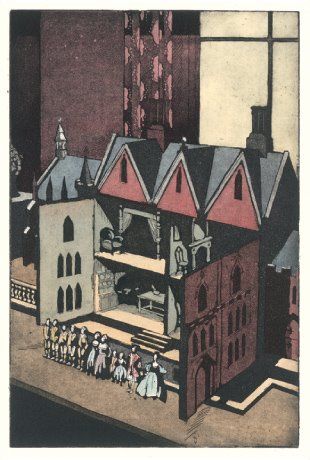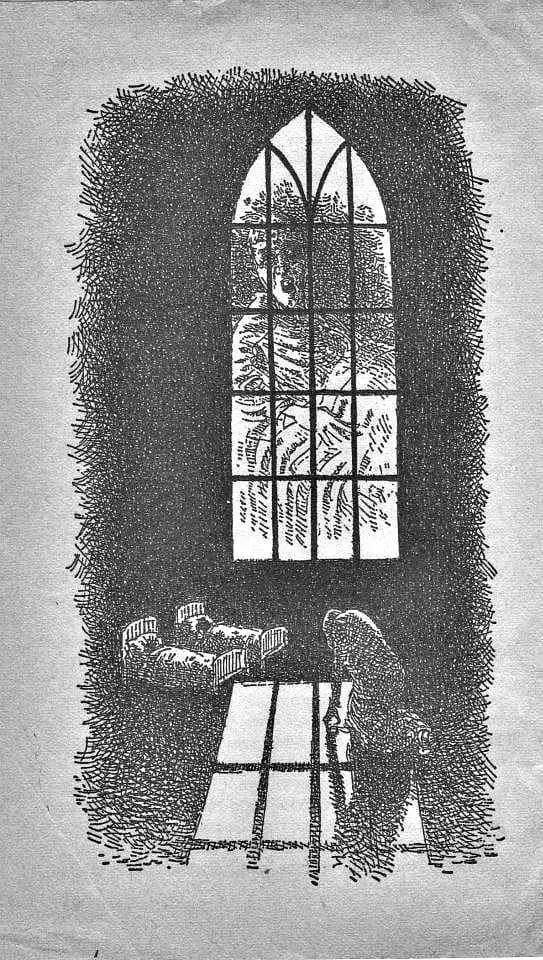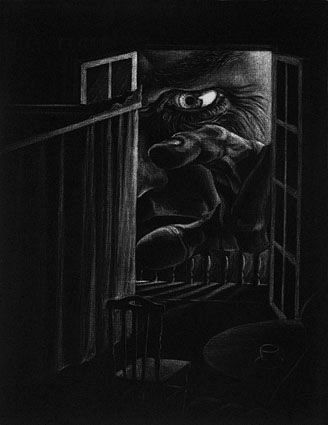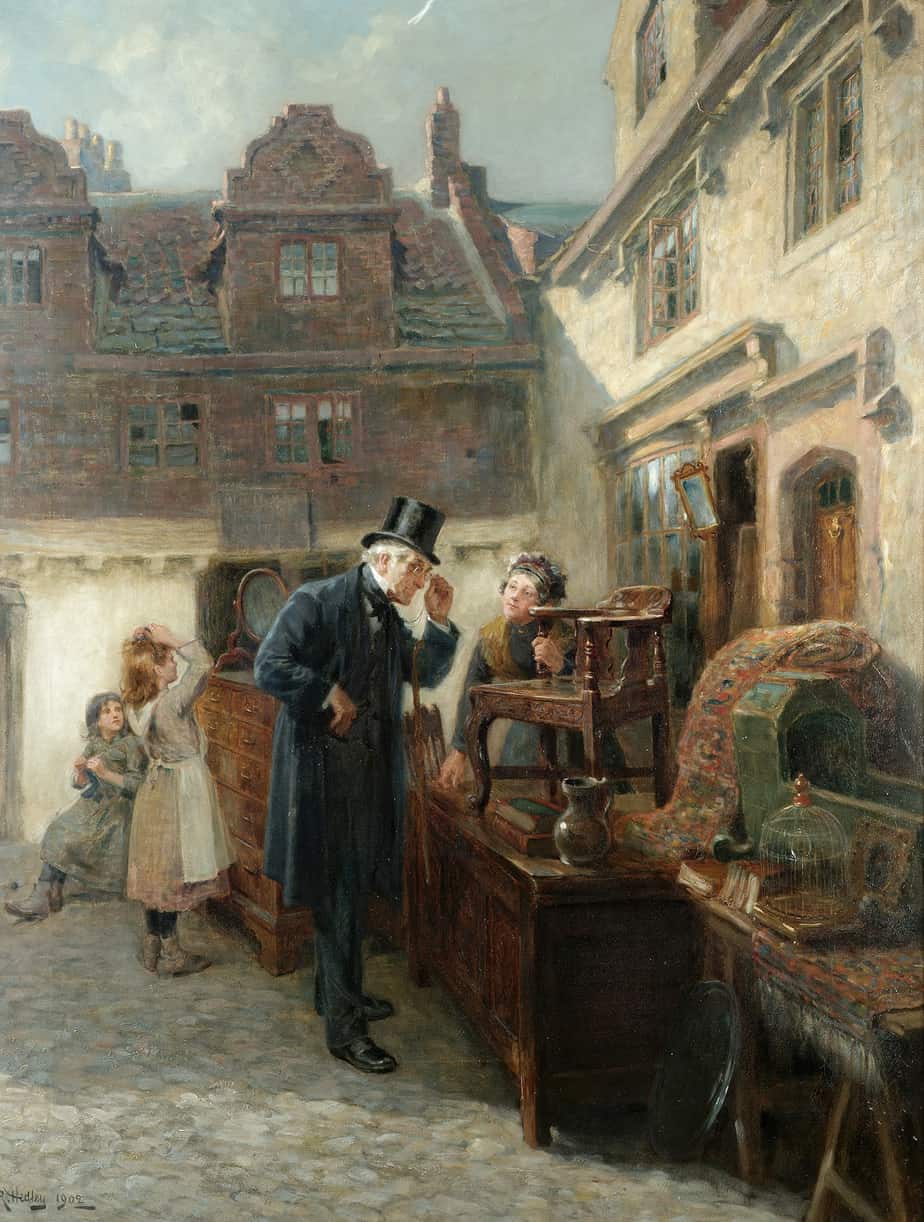“The Haunted Dolls’ House” (1923) is a short ghost story by Montague Rhodes James. Being out of copyright, you can read it at Project Gutenberg.
WHERE TO LISTEN
Here’s another version:
SETTING OF THE HAUNTED DOLLS’ HOUSE
- PERIOD — Contemporary at time of publication, the early 20th century or thereabouts.
- DURATION — A few days or weeks. The bulk of the story takes place overnight as Mr Dillet observes the goings-on inside his new haunted dolls’ house.
- LOCATION — England, where Gothic houses dot the spooky landscape.
- ARENA — By coincidence (which audiences may not buy in a different genre of work) both Mr Dillet and Mr Chittenden, who’ve met at the beginning of the story, both end up at the seaside where they meet again. (Roald Dahl uses this healthful custom in The Witches as a way to get the grandmother and the boy staying in a seaside hotel.) Mr Dillet’s doctor has told Mr Dillet to visit the seaside to calm his nerves, and the exact same advice has been given in regards to Mr Chittenden’s wife. Since it was once common to visit the seaside for health reasons, and since both men may be seeing the same doctor, and since the population was much smaller then, it’s not such a stretch to think the two men ran into each other.
- MANMADE SPACES — The Gothic building exists as a counterpoint to the modern houses which are starting to replace the old ghost-like edifices of an older, disappearing England.
- NATURAL SETTINGS — The city, then the seaside.
- WEATHER — Not relevant, so not raining, not snowing.
- TECHNOLOGY CRUCIAL TO THIS PARTICULAR STORY — This dolls’ house is not a dolls’ house meant for child’s play. We are told it comes from the lumber room of a wealthy household. (Saki wrote a short story called “The Lumber-Room” if you’d like a guided tour of what kinds of things were stored in there.) Rich people of yore would quite often commission a miniature version of their house. This is clearly what the dolls’ house of this story is meant to be. The architectural details are far too fine. So fine, in fact, that we cannot believe them. It’s one thing to recreate the miniature version of a Gothic cupola for a church bell and another thing to create miniature drawers which open and shut, and which have fabrics folded and stored inside them. If you’ve ever played with a doll house, you may be familiar with the frustration of fabric that isn’t sufficiently fine to be real. A fabric bedspread in miniature doesn’t have the weight to sit down as it overhangs the bed. The carpet of my childhood dolls’ house was cut to fit the rooms, but the knot count was far too high. This particular miniature house has been inspired by a building in Twickenham known as Strawberry Hill, which inspired a Gothic revival in England.
- LEVEL OF CONFLICT — The antiques dealer is one of life’s tricksters, and since audiences love tricksters, we also love antiques dealers, always out to get the best deal while utilising the skills of poker. This accounts for the number of reality TV shows which follow antiques dealers. Audiences also love the vicarious thrill of the bargain, and this story gives us both. It gives us both sides of the bargain; the guy who got the bargain (good for him!) and the couple who off-loaded the creepy thing (good for them!)
- THE EMOTIONAL LANDSCAPE — Mr Dillet is wrong to think that he can cheat death by focusing on making money. Death will make itself known!



STORY STRUCTURE OF THE HAUNTED DOLLS’ HOUSE
PARATEXT
I’m reading this short story in M.R. James: Collected Ghost Stories, a Wordsworth Classic. Cover copy says that ‘M.R. James is the finest ghost-story writer England has ever produced. These stories are classics not only of their genre, but also of beautiful paced understatement, convincing background and chilling terror’.
If this story is an example of perfect pacing, I deduce modern readers have come to expect faster paced stories than this one. (More on that below.)
In a postscript to this story, James has written:
It will be said, perhaps, and not unjustly, that this is no more than a variation on a former story of mine called The Mezzotint. I can only hope that there is enough of variation in the setting to make the repetition of the motif tolerable.
Clearly James is relying upon readers’ familiarity with well-established tropes, and he second-guesses himself. Has he done enough with these tropes to produce something new and exciting? I don’t see anything new here, but that’s only because subsequent writers have utilised techniques established by early masters such as M.R. James.
THE TITLE
In general, writers are advised to avoid giving away a big reveal in the title. This story is an interesting exception (maybe). The storyteller narrator opens with the interaction between the two pawnbrokers and addresses the narrattee by saying the ‘object … shall be described when the time comes’. Naturally, we know they’re talking about a haunted dolls’ house, in which case the reveal is not that it is a haunted dolls’ house, but what it looks like, and later, what dangers await the owner of a haunted dolls’ house. After its acquisition, James’ storyteller again breaks the fourth wall: ‘And what of Mr. Dillet and of his new acquisition? What it was, the title of this story will have told you. What it was like, I shall have to indicate as well as I can.’
James hasn’t actually broken the storytelling rule against spoiling a reveal in the title; the reveal is simply a different one. His title is in fact doing the bulk of the work of propelling us through that first scene.
(I appreciate that this story is one of the few to put the apostrophe of Dolls’ House in the right place. If more than one doll lives in a dolls’ house, the apostrophe goes AFTER the ‘s’!)
SHORTCOMING
M.R. James might have chosen to tell this story in first person directly via Mr Dillet. But that’s not the narration he goes for. He writes with an omniscient, storyteller narrator, who seems to have heard the story secondhand, because he (the unseen storyteller is clearly a ‘he’) glosses over details deemed unnecessary. This is the advantage of the storyteller narrator. The other advantage: the reader doesn’t from the outset know whether Mr Dillet dies. (A first person narrator still alive at the end has clearly not died.)
The disadvantage is this: James uses Mr Dillet purely as a puppet, but must at intervals filter the story through his eyes, reminding the reader that there is a man, Mr Dillet, looking at the dolls’ house.
Mr Dillet is a cosmic horror ‘main character’. He is really just a stand-in, and could be swapped out for anybody. We are not supposed to care about him, he has no character arc, he is wholly uninteresting. If he were interesting, his interestingness would take away from the horror of the haunted dolls’ house itself.
DESIRE
Mr Dillet and Mr Chittenden both want to make a lot of money. They’re concerned with little else, though this story will teach Mr Dillet that he can’t avoid life (and death) matters by focusing on the accumulation of wealth; life itself will intervene to teach him there’s more to the cosmos than money and oneupmanship.
OPPONENT
The true enemy of this story is some preternatural force beyond either Mr Dillet or Mr Chittenden. Mr Dillet and Chittenden are both very similar, and each understands the other’s desire to purchase a bargain for resale. (The wife is harder on Mr Dillet than Mr Chittenden. Perhaps she hasn’t realised she’s married to a Mr Dillet type herself.)
There’s another off-the-page opposition — some hypothetical American suckers who will buy the dolls’ house for more than it’s worth (overestimating the value of an artifact) and take it all the way across the Atlantic, where the Brits will never ever have to lay eyes upon it again. Thus, a vague anti-American sentiment runs through the story, but the Americans win, because by the story’s end, no American has bought it yet.
PLAN
Mr Dillet earns a living by procuring valuable goods for less than he can get for them elsewhere. His plan is to act nonchalant about a magnificent miniature house that Mr Chittenden is selling, so he can buy it dirt cheap.
THE BIG STRUGGLE
When he gets the dolls’ house home, he places it on his ‘large kneehole table, lighted up by the evening sun which came slanting through three tall sash-windows.’
James makes use of the horror trope (and folk superstition) that something terrible must follow something too good to be true:
“Quintessence of Horace Walpole, that’s what it is: he must have had something to do with the making of it.” Such was Mr. Dillet’s murmured reflection as he knelt before it in a reverent ecstasy. “Simply wonderful! this is my day and no mistake. Five hundred pound coming in this morning for that cabinet which I never cared about, and now this tumbling into my hands for a tenth, at the very most, of what it would fetch in town. Well, well! It almost makes one afraid something’ll happen to counter it. Let’s have a look at the population, anyhow.”
The Haunted Dolls’ House
Conveniently for the story, Mr Dillet sleeps in the same room as he sometimes receives his visitors, and where he has placed the massive dolls’ house. He is woken up by a single toll of the bell, then wakes up to see the dolls inside the house have come alive.
The bulk of the words in this short story describe what Mr Dillet sees through the windows of the miniature house, which is no longer a doll house, but part of a landscape of its own, dominating Mr Dillet’s room and expanding the boundaries of the walls. The miniature morphs into life-size.
Children’s picture books often make use of this trope, and I’ve collected a number of examples in my post on Just A Dream by Chris Van Allsburgh.
This part of the story goes on and on and on, way beyond my tolerance for detail. Once I’ve got the idea that this is a Gothic miniature house with impossibly realistic details, I want to know what happens next.
ANAGNORISIS
Mr Dillet doesn’t like the cut of these dolls’ jib. He realises that the dolls’ house is evil, and the funereal proceedings inside suggest death, and quite possibly augur death for himself.
He realises he doesn’t feel very well so the following morning he visits his doctor, who tells him to visit the seaside. At the seaside, he encounters Mr Chittenden, who previously owned the miniature house, and realises he’s not going mad; his observations can be verified by another man, and he’s therefore seeing some kind of preternatural truth.
NEW SITUATION
Mr Dillet still intends to sell the thing, but is waiting for an American buyer, we assume so that it is far, far away from England, nice and safe. But at story’s close, it is sitting under a sheet. Mr Dillet has moved it only as far as his stable.
EXTRAPOLATED ENDING
If I read this story symbolically, the dolls’ house is a reminder of death. Shrunk down to miniature, the haunted house allows the regular sized Mr Dillet an omniscient view on the lives of its doll inhabitants. When storytellers want the reader to feel omniscient, or to have some kind of revelation, or to consider life as a complete thing from birth til death, they will often take us to some elevated place. It might be to a mountaintop or a rooftop, but another spin on that is to make us ‘giants’ in a miniature world.
Mr Dillet can never get rid of this deathly dolls’ house because he has seen his own demise, and he’s had a mid-life equivalent of a Being-toward-death revelation, and realised he cannot escape death. It’s waiting for him right there, in his very own stable, mostly out of sight, but never far away.
RESONANCE
Does this story intrigue you as it intrigued an early 20th century audience? I put it to you that the pacing of modern short stories is a bit different, because modern audiences have less tolerance for the ‘build up’ technique in which the author lists detail after detail in the name of building suspense.
“The Haunted Dolls’ House” is one of many stories in which the characters inside a dolls’ house come alive. Horror tropes are frequently repurposed by children’s book writers, and the dolls’ house is especially beloved because it is a familiar chidren’s toy.
FURTHER READING
- Symbolism of the Dollhouse in storytelling
- “The Doll’s House” by Katherine Mansfield
- Cutaway houses in picture books were popular in the 20th century. M.R. James creates a cutaway visual using words.
Header illustration: Ralph Hedley – Real Antique

